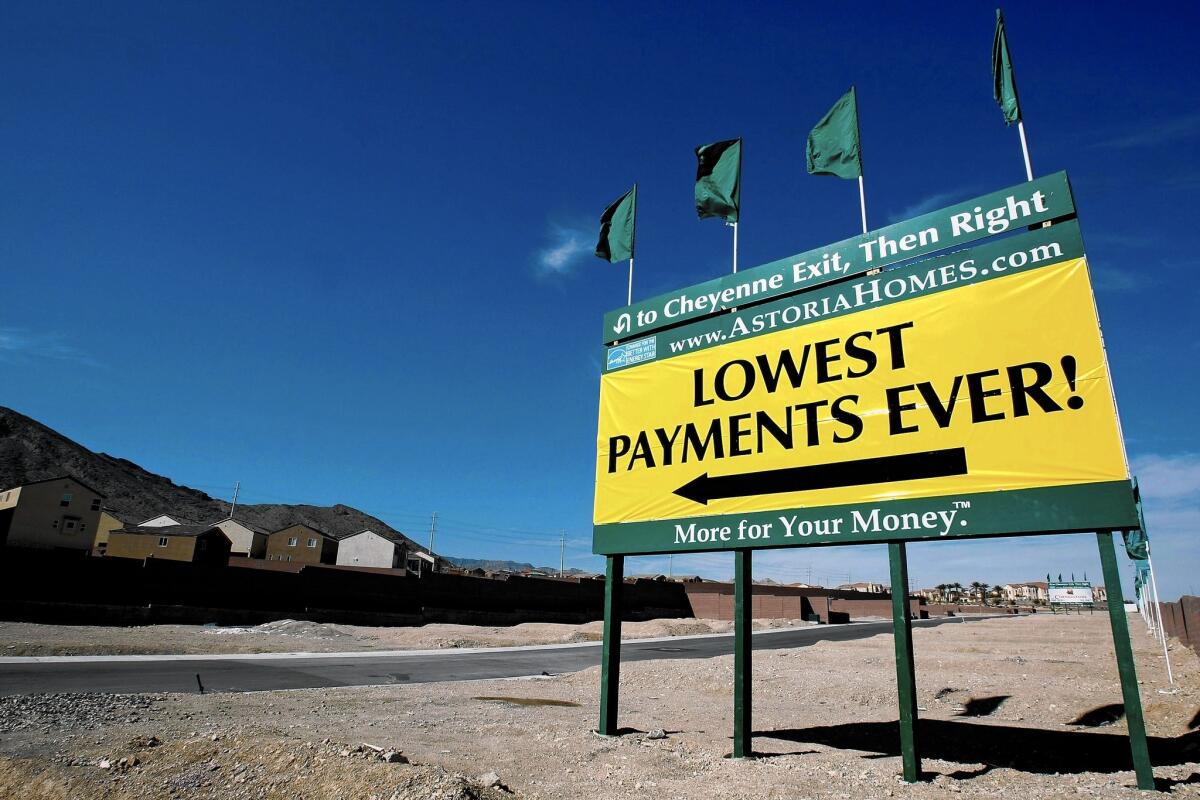S&P is expected to settle litigation over its role in financial crisis

In May 2004, as the U.S. housing market was heating up, Standard & Poor’s Financial Services lost to a rival a huge deal to rate mortgage-backed securities to be issued by a major Japanese bank.
The reason? S&P’s credit standards were too high, an employee complained to his boss.
The company then went on to “downplay and disregard” its standards to win business, a federal lawsuit alleged, contributing to one of the most devastating financial collapses in history.
As early as Tuesday, S&P is expected to settle with federal and state authorities, including officials in California, for a total of nearly $1.4 billion, said a person familiar with the deal but not authorized to speak publicly.
The litigation, filed two years ago, was the first against a ratings company for its role in the financial crisis that deepened the Great Recession.
The company is not expected to admit liability over allegations that it defrauded banks and other investors by doctoring its top AAA ratings on securities to attract Wall Street clients. Investors rely on ratings to a great extent to assess the safety and soundness of stocks, bonds and other assets.
One observer said the settlement would offer at least some accountability for a key player in the financial crisis.
“Without the investment-grade ratings bestowed on pools of substandard mortgages, there would have been no mortgage crisis,” said Jan Lawrence Handzlik of Los Angeles, a former federal prosecutor who specializes in white-collar criminal defense.
“It’s difficult to determine if the penalty ... is too little too late or just about right,” he said. “But the resolution of this fraud lawsuit on these terms should have a significant deterrent impact.”
The deal also marks an important milestone for the much-criticized ratings business, which today is more stringently regulated but more lucrative than before the crisis.
“It’s an important step to closing the books on the financial crisis as it related to the ratings agencies,” said Peter P. Appert, an analyst with Piper Jaffray & Co. in San Francisco.
With the agreement in hand, federal authorities now are taking aim at S&P’s key rival, Moody’s Investor Services, said people familiar with that investigation but unauthorized to speak publicly. Moody’s declined to comment.
Under the terms of the expected S&P settlement, half the payment, $687.5 million, will go to the Justice Department, and the rest to 19 states and the District of Columbia. California, which had sued S&P separately, will receive $210 million, believed to be the largest recovery among the states.
The bulk of the California settlement will go to the state’s two major public pension funds, the California Public Employees’ Retirement System and the California State Teachers’ Retirement System. Both relied on S&P ratings in buying securities that later crashed, according to the state’s case.
S&P, which denied the allegations and said emails about the Japanese deal were taken out of context, also said the federal lawsuit was brought in retaliation for the company’s decision to downgrade U.S. debt during the 2011 budget standoff between President Obama and congressional Republicans. The settlement is expected to say that S&P didn’t find evidence to support the claim.
The decision to allow S&P to settle without admitting to fraud was a key concession also won by other major financial institutions in prior settlements with the Justice Department and the states. The agreement’s statement of facts is not expected to contain any finding of a violation of law, a person with knowledge of the agreement said.
The statement, however, is expected to say that the company was aware of deteriorating conditions in the mortgage market that would normally require it to warn investors by lowering ratings on the bonds, an action known as a downgrade, according to another person familiar with the matter.
The company failed to downgrade the bonds out of concern for losing business from Wall Street banks, which issued the bonds and paid for the ratings, this person said.
Spokespeople for S&P, the California attorney general’s office and the Justice Department declined to comment.
The settlement would be one more turn in the long and painful process of digging out of the financial crisis of 2008, which centered on the mortgage market and the type of mortgage-backed securities rated by S&P, Moody’s and their smaller rival, Fitch Ratings Inc.
As the housing market heated up in the mid-2000s, Wall Street banks rushed to market hundreds of billions of dollars worth of high-yielding, mortgage-related securities, each of which required a rating on their credit quality by one of the three firms that dominated the market.
Government investigations later faulted the raters, which are paid by the Wall Street firms whose bonds they rate, for conflicts of interests and said the companies lowered their credit standards to win new business. As the housing market faltered, the securities, many of them rated AAA, crashed in value, sending global financial markets into a tailspin.
The 2011 Financial Crisis Inquiry Commission called the rating companies “essential cogs in the wheel of financial destruction.”
Already, financial institutions in the U.S. and Europe have agreed to pay more than $178 billion in total litigation costs stemming from the crisis, according to a December study by Boston Consulting Group, including high-profile settlements between government agencies and JPMorgan Chase & Co., Citigroup Inc. and Bank of America Corp.
The federal suit was filed in U.S. District Court in Santa Ana, where federal prosecutors have deep experience bringing cases under the powerful Financial Institutions Reform, Recovery and Enforcement Act of 1989.
FIRREA, enacted to deal with the savings-and-loan crisis, imposes stiff financial penalties for causing losses at government-insured banks. The S&P lawsuit was the first major FIRREA case filed in the wake of the financial crisis.
Still, S&P and its competitors retain an effective oligopoly on the business. Piper Jaffray’s Appert said the three companies today control 95% of the global ratings market, about the same as before the crisis.
S&P’s revenue, about $2.4 billion last year, according to Appert, is higher than its pre-crisis peak.
From an investor standpoint, Appert said, the settlement is good news. On Monday, shares of S&P’s parent company, New York publisher McGraw Hill Financial Inc., gained 86 cents, or about 1%, to $90.30.
Starkman reported from New York; Reckard from Los Angeles.







